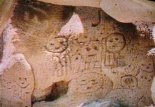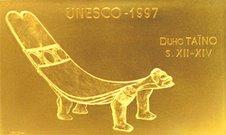 Miguel Sobaoko Koromo Sague, Mildrid Karaira Gandia, and Edgar Konuk Ceiba Rodriguez honor the winter solstice at a ceremonial gathering in Miami
Miguel Sobaoko Koromo Sague, Mildrid Karaira Gandia, and Edgar Konuk Ceiba Rodriguez honor the winter solstice at a ceremonial gathering in MiamiMiami, Florida (UCTP Taino News) - Astronomically marking the beginning of shortening nights and lengthening days, many cultures link the Winter Solstice with the concept of rebirth. Honoring the significance of the occasion, over 40 Taino community members and friends gathered on December 27th at Women’s Park in Miami, Florida for ceremonial “celebration of life.”
The Miami ceremony called "Taino Winter Solstice celebration" is a tradition of the Caney Indigenous Spiritual Circle, organized and facilitated by the Circle’s founder Miguel Sobaoko Koromo Sague. A Taino from the island of Cuba, Sobaoko Koromo stated “like our ancestors we recognize the [solar] cycle as a powerful spiritual element of our belief system.” He continued noting that this particular social ceremony honored a “return to the divine womb” which heralds rebirth.
Taino community members representing Cuba, Kiskeia, and Boriken were in attendance as well as members of other indigenous Nations including the Apache, Cree, and Mayan. Among the Mayan community of Guatemala the winter solstice is known as Wayeb’ or Uayeb and it represents the days leading up to the end of their solar calendar cycle.
Guatemala the winter solstice is known as Wayeb’ or Uayeb and it represents the days leading up to the end of their solar calendar cycle.
Mildred Karaira Gandia, a Boriken Taino representative of the United Confederation of Taino People in Florida also attended the ceremony with her son Justin and community elders Santos and Annette Irizarry. Karaira was honored to take a role in the ceremony as the representation of Attabey, the Earth Mother.
Remaking on the importance of the gathering Karaira stated “I am honored to be representing the UCTP at this ceremony in Miami as it is an opportunity to bring our people together as family as well as to honor this land area, which is a part of our ancestral homelands. Our ancestors - be they Taino from Cuba, Kiskeia, or Boriken - knew Florida as Bimini and many settled here. As descendants of those peoples we are not immigrants, this is also our home.”
The ceremony culminated with guaitiao (friendship) dance led by Edgar Konuk Ceiba Rodriguez and a feast featuring traditional Taino staples such as Yuka and Casabe bread.
The winter solstice occurs annually some time between December 20 and December 23 in the northern hemisphere, and between June 20 and June 23 in the southern hemisphere, during either the “shortest day” or “longest night of the year.”
UCTPTN 12.30.2008
Taino community members representing Cuba, Kiskeia, and Boriken were in attendance as well as members of other indigenous Nations including the Apache, Cree, and Mayan. Among the Mayan community of
 Guatemala the winter solstice is known as Wayeb’ or Uayeb and it represents the days leading up to the end of their solar calendar cycle.
Guatemala the winter solstice is known as Wayeb’ or Uayeb and it represents the days leading up to the end of their solar calendar cycle.Mildred Karaira Gandia, a Boriken Taino representative of the United Confederation of Taino People in Florida also attended the ceremony with her son Justin and community elders Santos and Annette Irizarry. Karaira was honored to take a role in the ceremony as the representation of Attabey, the Earth Mother.
Remaking on the importance of the gathering Karaira stated “I am honored to be representing the UCTP at this ceremony in Miami as it is an opportunity to bring our people together as family as well as to honor this land area, which is a part of our ancestral homelands. Our ancestors - be they Taino from Cuba, Kiskeia, or Boriken - knew Florida as Bimini and many settled here. As descendants of those peoples we are not immigrants, this is also our home.”
The ceremony culminated with guaitiao (friendship) dance led by Edgar Konuk Ceiba Rodriguez and a feast featuring traditional Taino staples such as Yuka and Casabe bread.
The winter solstice occurs annually some time between December 20 and December 23 in the northern hemisphere, and between June 20 and June 23 in the southern hemisphere, during either the “shortest day” or “longest night of the year.”
UCTPTN 12.30.2008










